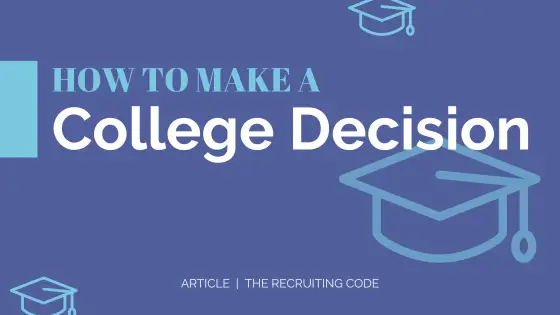How to Make a College Decision
Deciding which college to attend can be overwhelming. Categorizing and framing what is important to you can be very helpful. Formulating a matrix is not a new idea, but I am indebted to Tadaes Dias from the North West Arkansas Soccer Club for developing a matrix specific to college and athletic decisions.
One common way suggested to frame a decision is to make categories that are important to you and then make decisions based within this framework. It is a fantastic method and can open your eyes and keep your decision consistent what you really want. It can keep you grounded and from making a decision on an emotional whim.
The Decision Matrix
In this matrix there are five categories. The first is Sport, in which you consider the level of play and playing time. Second, Academics: studies and degrees offered by the school. Next, Campus and way of life: the values and mission of the school. In the Financial category, you will consider the overall cost versus any scholarships and financial aid. Finally, Distance: how far away from family and friends you want to be.
| Sport | Academics | Campus and way of life | Financial | Distance |
| Sport | Academics | Campus | Finances | Location |
| Academics | Campus | Finances | Location | Sport |
| Campus | Finances | Location | Sport | Academics |
| Finances | Location | Sport | Academics | Campus |
| Location | Sport | Academics | Campus | Finances |
This matrix has wonderful categories. It is not a one size fits all model. You can use these categories directly, or provide your own categories. Decide on your categories. List in order what is important to you. This will enable you to consider all options through the lens of what you really believe.
How Colleges and Coaches “Help” You Make the Right Decision
Colleges and coaches are not trying to assist you with making the best choice. They are interested in the best choices for them. And what are the best choices for them? Admissions wants as many warm bodies as possible; they want to add to the enrollment and revenue of the institution. The coach, if interested in having you on the team, is competing for you. They are trying to sell you on the school.
One tactic I often used, if I thought a recruit was close to a final decision, was to take them into the locker room and show them the uniform jerseys. I would tell them which numbers were open for the following year and throw in this helpful advice, “I hand out numbers to new players in the order they commit.” The recruit would pick a number she liked. I would hand her the jersey and ask if she wanted to try it on. Every time a mini photo op took place.
As a coach, I was looking for an emotional sell. I was not looking to sit down with the family and help them work through which of their final choices was best for them. For the coach, having you on the team is the best choice.
Minimize the Emotion and Maximize the Logic
You need a framework that helps you reign in the emotion. Take this scenario for example: early in the process you list finances as the most important, academics as your second choice, and sport is your third priority. This will impact your decision.
You narrow your choices down to two schools. The first choice is a dream sport program. The school does not have exactly what you want academically, but it is satisfactory. The coach has offered you $5,000 per year, and told you that you would be competing for a starting spot. The total cost to you, after all scholarships and grants, however, is $10,000. Your parents can pay $3,000 in cash. You will have to take out $7,000 in loans.
The other school was your top academic choice. You love the department and the professor you met. The coach will let you walk on and try to earn playing time, but there are no guarantees. The total cost out of pocket is $2,000. Your parents can cover this amount without any loan and have $1,000 to help you with other expenses.
Without a framework, this becomes an emotional decision. If you have worked out your priorities early on, this becomes an easier decision. You would have to actively disregard what you believe to choose the first college and the $7,000 loan. Apply logic to your decision.
Next, take a look at Grades Affect Athletic Scholarships.
A Guide to Researching Colleges
I have mentioned before that researching colleges is the first thing to do if you want to play the sport you love in college.
I realize that many of you have no idea where to start.
 If your family is struggling with the recruiting process. How to Get Recruited can give you a plan and help you with phone calls, emails, and how to get college coaches to recruit your child.
If your family is struggling with the recruiting process. How to Get Recruited can give you a plan and help you with phone calls, emails, and how to get college coaches to recruit your child.
How to Get Recruited Guide will give you a step-by-step plan to turn your child’s talent into offers.
How to Get Recruited: Got Talent. Get a Plan. Get Recruited.
Join The Recruiting Code Facebook group. This is the place for parents and coaches to talk about college recruiting. Come learn from each other, share stories, and get information that will help your child become a college athlete.


